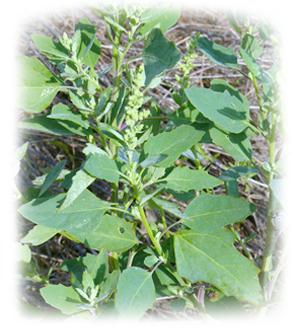Lamb’s-Quarters, white goosefoot, wild spinach, fat hen, chou gras
|
|
| Chenopodium album
Amaranthaceae
|
|
|
Legend and Lore Chenopodium translates from the Latin Goose-foot for the shape of the leaf that resembles a webbed foot; or the shape of a lamb’s hind quarter. Album refers to the grayish white mealy surface of the underside of the leaf. Grown as a food crop in Central America it is considered as an invasive weed in North America. Serve like spinach and has a similar taste to cabbage, rich in vitamin A, B and C, iron and calcium; seeds can be used as cereal and for giving a pumpernickel taste to baked goods. Prevented scurvy, treated stomach aches in Canada’s First Nation, was taken as a spring tonic. The juice from the stem was applied to freckles and sunburns. The stem was shaped into a snake figurine as a charm for snake bites, the crushed roots were used as a mild soap substitute and a hair wash, leaves stuffed into pillows or tied to clothes as a scent. Widely used during the Depression; during the Iron Age and found in Roman sites the seeds were mixed in with other grains and also found in the stomachs of the “Bog People” in Denmark.
|
|
|
In the Garden Common weed in garden, waste land; leaves alternate, v- shaped, coarse margin, mealy white underneath, basal, multi branched erect stems. Flowers late spring; tiny inconspicuous and greenish in a terminal cluster, followed by abundant seeds that are harvested in the autumn. |
|



